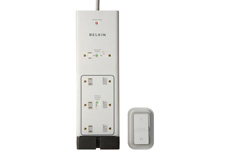CES: My day one highlight? A surge protector

As day one of CES comes to a close, some quick snapshots of three of the more interesting products I've come across both on the show floor, and at the myriad press-only events that accompany the show.
Belkin Conserve Surge Protector

The Belkin Conserve ($49.99, available this summer) solves that problem by including an RF remote control that allows you to turn off power to six of its outlets - the remaining two can be used for devices that require constant power, such as a PVR. When you want to turn on the other devices, simply flip the switch, and everything that's plugged into the strip will get juice again. The $49.99 cost could pay for itself pretty quickly with lowered energy bills, and it's a heck of a lot more convenient than constantly plugging and unplugging your power adapters.
Sony XEL-1 t OLED TV
It's not often that a new product can get compared to IBM's PCjr, the Apple Newton, and the Diamond Rio all in the same article, but that's the risk Sony's ran when it decided to launch an 11-inch TV that costs $2,500.
Slacker Portable Audio Player
The players, which range in price from $199 to $299, depending on the number of stations you want to access, will work with Slacker's free service. But if you want to take full advantage of all that Slacker has to offer - more stations, no commercials, and the ability to both save songs you like, and to skip through as many of the songs that you don't, you'll want to pony up for the company's premium service, which ranges from $7.50-$9.99 a month, depending on the length of contract. The Slacker Portable is an interesting product right out of the gate, but if the company can deliver on its promise, it gets really intriguing down the road, when the company introduces a satellite dock for the player, potentially making the player a far-less expensive alternative to XM and Sirius.
Though I only played with the product for a couple of minutes, I found the UI to be fairly intuitive, though the device itself felt a bit cheap, and in fact, the display on one of the two that I saw on display actually refused to turn on.